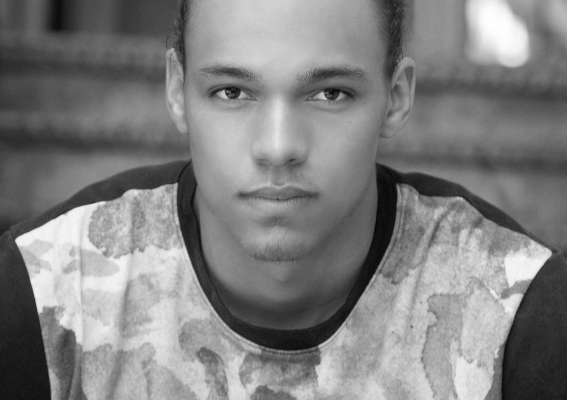King of Pain: Senior draws on years of training to rise through ranks in taekwondo
By Nathan Hoy on February 25, 2016
By: Nathan Hoy
Pain. It’s something everyone will encounter at some point in their lives. It’s something that is inevitable and always an unfortunate surprise. Pain can be inflicted intentionally, accidentally or without any heads up.
For the most part pain isn’t a choice; however, what is is a choice is the way one will react to the pain. Some will succumb to it, some will use it as a source of emotion and some will push past the warning sensation sent to one’s brain that some type of stimulus is causing or may cause damage.
For senior Isaiah Barney, he has chosen the option to battle through the neurotransmitters’ signals and learn to push past something that most human beings would quickly surrender to.
Barney is part of a small group of people who not only takes part in but is also highly successful in an art that’s been around since 1945: taekwondo.
This sport has been in the Barney household for many years and was passed down from father to son. Barney’s father started taking part in this extraordinary lifestyle when he was only in fifth grade. He is now a fourth degree black belt and is a highly decorated fighter. His dad was teaching classes at Peak Performance, so when Barney was just in third grade, he started competing. He would always sit in on classes and had been watching and looking up to his dad since the time he could walk.
To be able to move up in rank, participants must test out of their previous ranks. The testing periods are different for each belt; however, one year of training must be completed before anyone can test again.
For any rank past a black belt there must also be an additional year. There are eight different stages to get to a black belt, and after participants have completed all eight, they are still not technically a black belt, only a recommended black belt.
Barney said once one earns a third degree black belt, one is considered a master. “There are three different phases when it comes to testing,” Barney said. The first is a set routine of attacks and blocks. The second is sparring where they pair the person up with the same skill level or they will spar with the master in the gym. The last phase or test is board breaking.
There is a wide variety when it comes to this skill. Basically candidates have to break a certain amount of boards, and as long as they get broken, it is sufficient enough. “I broke three stacks with my elbow, one with a one inch punch and three with a side kick,” Barney said. “This got me to the recommended black belt. The next step is to get back in the gym for another two or three months and get working on my new form.”
The gym where practices are held was moved to the Rock Gym and practice is held every Monday, Wednesday, Friday and Saturday. “Practice is intense but I continually look forward to it,” Barney said.
Every practice starts with stretching. They stretch what would seem like a long time for any other athlete, and then they stretch some more. “The last thing you want is to pull something while doing a high kick or something that takes high flexibility and athleticism,” Barney said.
The athletes then line up from front to back of the gym by rank, and the master goes to the front. After bowing to the flags and senior students, the athletes begin to warm up with limbering kicks and swinging of their legs as high as possible.
They then get back into their lines and begin to work on their kicks by kicking paddles. The kicks can vary from roundhouse kicks to side kicks to combinations. They will then break off and work on form or learn new forms.
Depending on the day, they may condition, which could be anything from sprints up and down the gym, standing in place conditioning or sparring. When sparring, they use chest protectors, arm guards, chin guards and foam helmets.
During competition the competitors will break off by weight class and rank. They will then weigh each competitor to make sure of the correct weight, and if someone is too heavy he or she will likely have to run a few laps to make weight.
The judges will then check toenails and fingernails to make sure they aren’t too long, and when cleared, the athlete will be directed to where the fight will take place. “I like to watch my competition and try to find out what their strengths and weaknesses are,” Barney said. “You can always learn a lot by watching your competitor.”
Even before the fight, Barney said he continues to stretch and constantly stresses the importance of that. When the fight begins, the competitors bow and shake hands. There are three rounds, and each round lasts 60 seconds; however, there is a mercy rule where if an opponent goes up so many points, then he or she will automatically win.
For younger groups, there is a rule put in place that contact to the head can’t be too strong. During the fight, head shots are worth two point, but there are special moves like a spin hook kick, which is worth three points. A shot to the chest is worth one point; however, the same rule applies, and special moves can be as much as two points.
The chest protectors have certain sensors in them to indicate whether they have been hit or not, which automatically scores the points.
At the end of the fight, the two shake hands and wait for the next fight. There are usually about 10 people in each weight class and around three to four fights in two hours, but that all depends on a lot of things.
“It’s a kind of competition you can’t find anywhere else,” Barney said. “It also attributes greatly to my athletic ability, but more than anything, it builds up mental toughness. It forces you to get to that point in your mind where you just push past the pain. Protectors most definitely don’t take away all the pain. It still hurts immensely. You just gotta keep fighting.”
Search
News

Colleges returning to using standardized testing for admissions
Annie Seery | April 17, 2024Standardized testing has long been debated over. Now with many colleges after the pandemic requiring SAT scores again to apply, many students struggle to rise above their scores. These...
-
 Hanna Lane | April 17, 2024
Hanna Lane | April 17, 2024
-
 Hanna Lane | April 9, 2024
Hanna Lane | April 9, 2024
-
 Hanna Lane | April 2, 2024
Hanna Lane | April 2, 2024
-
 Annie Seery | March 28, 2024
Annie Seery | March 28, 2024
-
About
The Tiger Hi-Line Online is an award-winning creation produced by the journalism students at Cedar Falls High School. We produce written, photographic and video stories of the latest news around campus as well as teen-centered topics from around the world. The content is created entirely by students, primarily from the newspaper, broadcast and yearbook courses at Cedar Falls High School. Please email any story ideas to hilinestaff@gmail.com.Tags
2018-2019 2019-2020 alayna yates AOTW art artist of the week athlete of the week basketball books Cedar Falls High School CFHS choir Christmas college COVID donald trump Eden Davis entertainment Erin McRae feature Football games halloween home homecoming Iowa Jaden Merrick jared hylton movies music news opinion our view politics prom robotics Sabine Martin Sal Engle Skylar Promer Sophia Schillinger sports state Swimming video games volleyball




You must be logged in to post a comment Login